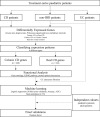Characterization of terminal-ileal and colonic Crohn's disease in treatment-naïve paediatric patients based on transcriptomic profile using logistic regression
- PMID: 34098982
- PMCID: PMC8185924
- DOI: 10.1186/s12967-021-02909-z
Characterization of terminal-ileal and colonic Crohn's disease in treatment-naïve paediatric patients based on transcriptomic profile using logistic regression
Erratum in
-
Correction to: Characterization of terminal-ileal and colonic Crohn's disease in treatment-naïve paediatric patients based on transcriptomic profile using logistic regression.J Transl Med. 2021 Aug 3;19(1):329. doi: 10.1186/s12967-021-02945-9. J Transl Med. 2021. PMID: 34344413 Free PMC article. No abstract available.
Abstract
Background: Inflammatory bowel disease (IBD) is a chronic and idiopathic inflammatory disorder of the gastrointestinal tract and comprises ulcerative colitis (UC) and Crohn's disease (CD). Crohn's disease can affect any part of the gastrointestinal tract, but mainly the terminal ileum and colon. In the present study, we aimed to characterize terminal-ileal CD (ICD) and colonic CD (CCD) at the molecular level, which might enable a more optimized approach for the clinical care and scientific research of CD.
Methods: We analyzed differentially expressed genes in samples from 23 treatment-naïve paediatric patients with CD and 25 non-IBD controls, and compared the data with previously published RNA-Seq data using multi-statistical tests and confidence intervals. We implemented functional profiling and proposed statistical methods for feature selection using a logistic regression model to identify genes that are highly associated in ICD or CCD. We also validated our final candidate genes in independent paediatric and adult cohorts.
Results: We identified 550 genes specifically expressed in patients with CD compared with those in healthy controls (p < 0.05). Among these DEGs, 240 from patients with CCD were mainly involved in mitochondrial dysfunction, whereas 310 from patients with ICD were enriched in the ileum functions such as digestion, absorption, and metabolism. To choose the most effective gene set, we selected the most powerful genes (p-value ≤ 0.05, accuracy ≥ 0.8, and AUC ≥ 0.8) using logistic regression. Consequently, 33 genes were identified as useful for discriminating CD location; the accuracy and AUC were 0.86 and 0.83, respectively. We then validated the 33 genes with data from another independent paediatric cohort (accuracy = 0.93, AUC = 0.92) and adult cohort (accuracy = 0.88, AUC = 0.72).
Conclusions: In summary, we identified DEGs that are specifically expressed in CCD and ICD compared with those in healthy controls and patients with UC. Based on the feature selection analysis, 33 genes were identified as useful for discriminating CCD and ICD with high accuracy and AUC, for not only paediatric patients but also independent cohorts. We propose that our approach and the final gene set are useful for the molecular classification of patients with CD, and it could be beneficial in treatments based on disease location.
Keywords: Colonic CD; Crohn’s disease; Logistic regression; Paediatric patients; Terminal-ileal CD; Transcriptomic profile.
Conflict of interest statement
The authors declare that they have no known competing financial interests or personal relationships that could have appeared to influence the work reported in this paper.
Figures







References
-
- Balzola F, Cullen G, Ho GT, Russell RK. The role of the environment in the development of paediatric inflammatory bowel disease. Inflamm Bowel Dis Monit. 2013:31–2.
Publication types
MeSH terms
LinkOut - more resources
Full Text Sources
Medical

